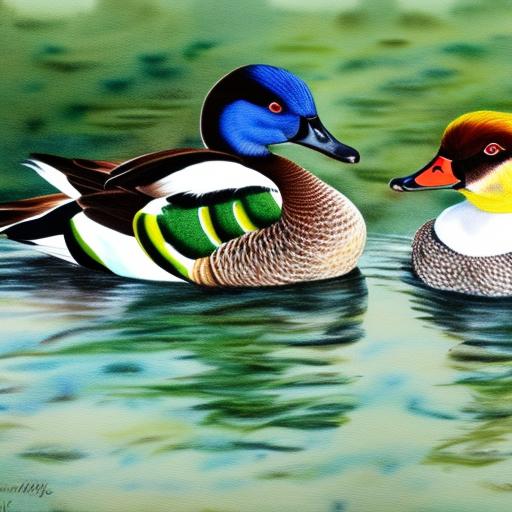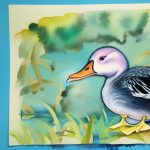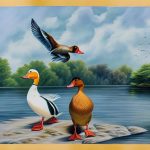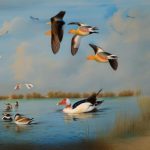Green headed duck breeds are a unique and beautiful group of ducks known for their striking green plumage on their heads. These ducks are popular among bird enthusiasts and are often kept as pets or for exhibition purposes. Green headed duck breeds are also found in the wild, where they play an important role in the ecosystem. There are several different breeds of green headed ducks, each with its own distinct characteristics and traits. In this article, we will explore the various characteristics of green headed duck breeds, popular breeds, breeding and rearing practices, their role in the wild, conservation efforts, and the future of these stunning birds.
Key Takeaways
- Green headed duck breeds are a unique and diverse group of ducks known for their striking green-colored heads.
- These ducks are characterized by their vibrant plumage, distinctive beak shapes, and varied sizes, making them popular among breeders and enthusiasts.
- Some popular green headed duck breeds include the Mallard, the American Black Duck, and the Northern Pintail, each with its own unique traits and characteristics.
- Breeding and rearing green headed ducks requires careful attention to their specific needs, including proper housing, diet, and breeding practices.
- Conservation efforts for green headed duck breeds are crucial to ensure their survival in the wild, as habitat loss and hunting pose significant threats to their populations.
Characteristics of Green Headed Duck Breeds
Green headed duck breeds are known for their vibrant green plumage on their heads, which is their most distinctive feature. They also have a sleek and streamlined body, with webbed feet that make them excellent swimmers. These ducks come in a variety of colors, including white, black, and various shades of brown. They are medium-sized ducks, with males typically being larger and more colorful than females. Green headed duck breeds are known for their friendly and sociable nature, making them popular choices for backyard ponds and water features. They are also known for their hardiness and adaptability to different climates, making them suitable for a wide range of environments.
Green headed duck breeds are also known for their excellent foraging abilities, as they are natural omnivores. They will eat a variety of foods, including insects, small fish, aquatic plants, and grains. This makes them relatively easy to care for, as they can find much of their own food in a natural setting. Green headed duck breeds are also known for their distinctive quacking sound, which is a familiar sound in many wetland areas where these ducks are found. Overall, green headed duck breeds are beautiful, sociable, and adaptable birds that make a wonderful addition to any water feature or pond.
Popular Green Headed Duck Breeds
There are several popular green headed duck breeds that are well-known among bird enthusiasts and breeders. One of the most popular breeds is the Mallard duck, which is known for its stunning iridescent green head and vibrant plumage. Mallard ducks are commonly found in the wild across North America and Europe, and they are also popular choices for domestication due to their friendly nature and striking appearance. Another popular green headed duck breed is the Cayuga duck, which is known for its unique black plumage with hints of iridescent green. Cayuga ducks are popular for their beauty and calm demeanor, making them a favorite among backyard duck enthusiasts.
The Rouen duck is another popular green headed breed, known for its large size and striking green head. Rouen ducks are often used for exhibition purposes due to their impressive size and beautiful plumage. Other popular green headed duck breeds include the Swedish Blue duck, the East Indies duck, and the Saxony duck. Each of these breeds has its own unique characteristics and traits, making them popular choices for both domestication and exhibition.
Breeding and Rearing Green Headed Ducks
Breeding and rearing green headed ducks can be a rewarding experience for bird enthusiasts and breeders. When breeding green headed ducks, it is important to provide a suitable environment for nesting and raising young ducklings. This may include providing a safe and secure nesting area near water, as well as access to suitable food sources for both the adult ducks and their young. Green headed ducks are typically good parents and will care for their young diligently, but it is still important to provide a safe and nurturing environment for the ducklings to thrive.
When rearing green headed ducklings, it is important to provide them with a balanced diet that includes a mix of commercial duck feed and natural foods such as insects and aquatic plants. It is also important to provide access to clean water for swimming and bathing, as this is essential for the health and well-being of young ducks. Rearing green headed ducks requires patience and dedication, but it can be a rewarding experience to watch these beautiful birds grow and thrive.
Green Headed Duck Breeds in the Wild
In the wild, green headed duck breeds play an important role in the ecosystem as they help control insect populations, disperse seeds, and provide food for predators such as foxes and birds of prey. Green headed ducks are also important indicators of wetland health, as they rely on healthy wetland habitats for nesting and feeding. Many green headed duck breeds are migratory birds, traveling long distances between their breeding and wintering grounds. This makes them important ambassadors for wetland conservation, as they rely on healthy wetland habitats throughout their annual cycle.
In the wild, green headed duck breeds can be found in a variety of wetland habitats, including marshes, ponds, lakes, rivers, and coastal estuaries. These habitats provide essential resources such as food, nesting sites, and protection from predators. Green headed ducks are well-adapted to life in wetland environments, with their webbed feet and streamlined bodies allowing them to navigate through water with ease. They are also well-camouflaged in their natural habitats, making them less vulnerable to predation.
Conservation Efforts for Green Headed Duck Breeds

Conservation efforts for green headed duck breeds are essential to ensure the long-term survival of these beautiful birds. Wetland conservation is crucial for the protection of green headed duck habitats, as healthy wetlands provide essential resources such as food, nesting sites, and protection from predators. Conservation organizations work to protect and restore wetland habitats through initiatives such as habitat restoration, land acquisition, and public education. These efforts help ensure that green headed ducks have access to suitable habitats throughout their annual cycle.
In addition to habitat conservation, efforts to reduce pollution and mitigate climate change are also important for the conservation of green headed duck breeds. Pollution from agricultural runoff, industrial waste, and urban development can have detrimental effects on wetland habitats, impacting water quality and food availability for green headed ducks. Climate change can also have significant impacts on wetland habitats through changes in precipitation patterns and sea level rise. Conservation efforts that address these threats are essential for the long-term survival of green headed duck breeds.
The Future of Green Headed Duck Breeds
In conclusion, green headed duck breeds are unique and beautiful birds that play an important role in both domestication and the wild. With their striking green plumage on their heads and sociable nature, they are popular choices for bird enthusiasts and breeders. However, conservation efforts are essential to ensure the long-term survival of these stunning birds. By protecting and restoring wetland habitats, reducing pollution, and mitigating climate change, we can help ensure that green headed duck breeds continue to thrive for generations to come. Whether in domestication or in the wild, green headed duck breeds bring beauty and vitality to our world, making them worthy of our conservation efforts.
If you’re interested in learning more about green-headed duck breeds, you might also want to check out Poultry Wizard’s article on “How Many Chickens Do You Need for a Family of 4?” This informative piece provides valuable insights into the practical aspects of raising poultry for a family, offering helpful tips and considerations for those looking to start their own backyard flock. You can find the article here.
FAQs
What are green headed duck breeds?
Green headed duck breeds are a group of duck species that are characterized by their distinctive green-colored heads. These breeds are known for their vibrant plumage and are popular among bird enthusiasts.
What are some examples of green headed duck breeds?
Some examples of green headed duck breeds include the Mallard, the American Black Duck, the Northern Pintail, and the Green-winged Teal. These breeds are commonly found in North America and are known for their striking appearance.
What is the habitat of green headed duck breeds?
Green headed duck breeds can be found in a variety of habitats, including wetlands, marshes, lakes, and rivers. They are often migratory birds and can be found in different regions depending on the time of year.
What do green headed duck breeds eat?
Green headed duck breeds are omnivorous and feed on a variety of foods, including aquatic plants, insects, small fish, and crustaceans. They are well-adapted to their aquatic habitats and have specialized bills for foraging.
Are green headed duck breeds endangered?
While some species of green headed duck breeds may be threatened or endangered due to habitat loss and hunting, many populations are stable and not currently at risk. Conservation efforts are in place to protect these beautiful birds and their habitats.
Meet Walter, the feathered-friend fanatic of Florida! Nestled in the sunshine state, Walter struts through life with his feathered companions, clucking his way to happiness. With a coop that’s fancier than a five-star hotel, he’s the Don Juan of the chicken world. When he’s not teaching his hens to do the cha-cha, you’ll find him in a heated debate with his prized rooster, Sir Clucks-a-Lot. Walter’s poultry passion is no yolk; he’s the sunny-side-up guy you never knew you needed in your flock of friends!







